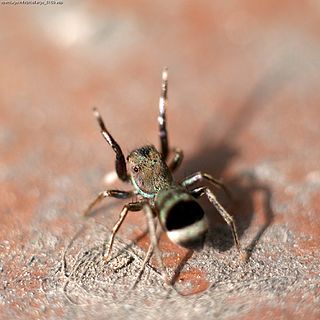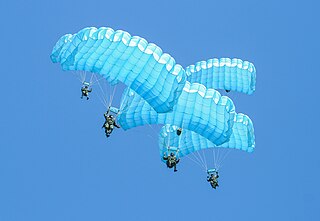
The high jump is a track and field event in which competitors must jump unaided over a horizontal bar placed at measured heights without dislodging it. In its modern, most-practiced format, a bar is placed between two standards with a crash mat for landing. Since ancient times, competitors have introduced increasingly effective techniques to arrive at the current form, and the current universally preferred method is the Fosbury Flop, in which athletes run towards the bar and leap head first with their back to the bar.

The long jump is a track and field event in which athletes combine speed, strength and agility in an attempt to leap as far as possible from a takeoff point. Along with the triple jump, the two events that measure jumping for distance as a group are referred to as the "horizontal jumps". This event has a history in the ancient Olympic Games and has been a modern Olympic event for men since the first Olympics in 1896 and for women since 1948.

The triple jump, sometimes referred to as the hop, step and jump or the hop, skip and jump, is a track and field event, similar to long jump. As a group, the two events are referred to as the "horizontal jumps". The competitor runs down the track and performs a hop, a bound and then a jump into the sand pit. The triple jump was inspired by the ancient Olympic Games and has been a modern Olympics event since the Games' inception in 1896.
Show jumping is a part of a group of English riding equestrian events that also includes eventing, hunters, and equitation. Jumping classes are commonly seen at horse shows throughout the world, including the Olympics. Sometimes shows are limited exclusively to jumpers. Sometimes jumper classes are offered in conjunction with other English-style events. Sometimes, show jumping is but one division of a very large, all-breed competition that includes a very wide variety of disciplines. Jumping classes may be governed by various national horse show sanctioning organizations, such as the United States Equestrian Federation or the British Showjumping Association. International competitions are governed by the rules of the International Federation for Equestrian Sports.
Jumper or Jumpers may refer to:

Jumping spiders are a group of spiders that constitute the family Salticidae. As of 2019, this family contained over 600 described genera and over 6,000 described species, making it the largest family of spiders at 13% of all species. Jumping spiders have some of the best vision among arthropods and use it in courtship, hunting, and navigation. Although they normally move unobtrusively and fairly slowly, most species are capable of very agile jumps, notably when hunting, but sometimes in response to sudden threats or crossing long gaps. Both their book lungs and tracheal system are well-developed, and they use both systems. Jumping spiders are generally recognized by their eye pattern. All jumping spiders have four pairs of eyes, with the anterior median pair being particularly large.

Jumper is a 2008 American science fiction action film loosely based on Steven Gould's 1992 novel of the same name. Directed by Doug Liman, the film stars Hayden Christensen as a young man capable of teleporting, as he is chased by a secret society intent on killing him. Jamie Bell, Rachel Bilson, Max Thieriot, AnnaSophia Robb, Diane Lane, Michael Rooker, and Samuel L. Jackson also star.
A skipping rhyme, is a rhyme chanted by children while skipping. Such rhymes have been recorded in all cultures where skipping is played. Examples of English-language rhymes have been found going back to at least the 17th century. Like most folklore, skipping rhymes tend to be found in many different variations. The article includes those chants used by English-speaking children.

Phidippus audax, the bold jumper or bold jumping spider, is a common species of spider belonging to the genus Phidippus, a group of jumping spiders easily identified by their large eyes and their iridescent chelicerae. Like all jumping spiders, they have excellent stereoscopic vision that aids them in stalking prey and facilitates visual communication with potential mates during courting. Bold jumping spiders are native to North America and have been introduced to Hawaii, Nicobar Islands, Azores, and the Netherlands. They are typically black with a distinct white triangle on their abdomen.
Natta is a genus of jumping spiders that was first described by Ferdinand Anton Franz Karsch in 1879. As of July 2019 it contains only two species, found only in Africa and Yemen: N. chionogaster and N. horizontalis.

Siler is a genus of Asian jumping spiders that was first described by Eugène Louis Simon in 1889. They specialize in hunting ants.

Myrmaplata plataleoides, also called the red weaver-ant mimicking jumper, is a jumping spider that mimics the Asian weaver ant in morphology and behaviour. This species is found in India, Sri Lanka, China and many parts of Southeast Asia.

Parachuting and skydiving is a method of transiting from a high point in an atmosphere to the ground or ocean surface with the aid of gravity, involving the control of speed during the descent using a parachute or parachutes.

Abigail Irozuru is an English track and field athlete, specialising in long jump. She was sponsored by Virgin Trains West Coast and had a Class 390 Pendolino train named after her in September 2011.

Impulse is a 2013 novel by Steven Gould, the third novel in the Jumper series and the fourth in the "Jumper" universe. The first two novels tell a connecting story which is continued in Impulse. A sequel to Impulse, called Exo, was published on 9 September 2014.
Spartaeus spinimanus, the spiny-legged jumper, is a species of spider of the genus Spartaeus. It is found from Sri Lanka to Borneo, and Sumbawa. The most preferred prey is moths, where the spider builds large sheet webs on tree trunks to capture them.
Emily Levesque is an American astronomer and assistant professor in the Department of Astronomy at the University of Washington. She is renowned for her work on massive stars and using these stars to investigate galaxy formation. In 2014, she received the Annie Jump Cannon Award for her innovative work on gamma ray bursts and the Sloan Fellowship in 2017. In 2015, Levesque, Rachel Bezanson, and Grant R. Tremblay published an influential paper, which critiqued the use of the Physics GRE as an admissions cutoff criterion for astronomy postgraduate programs by showing there was no statistical correlation between applicant's score and later success in their academic careers. Subsequently, the American Astronomical Society adopted the stance that the Physics GRE should not be mandatory for graduate school applications, and many graduate astronomy programs have since removed the Physics GRE as a required part of their graduate school applications. She is also the author of the 2020 popular science book The Last Stargazers: The Enduring Story of Astronomy's Vanishing Explorers.

Heliophanus cupreus, the copper sun jumper, is a species of jumping spider belonging to the family Salticidae.

Lyssomanes viridis, commonly known as the magnolia green jumper, is a species of jumping spider of the genus Lyssomanes, for which it is the type species. The species' native range extends through much of North America and Central America.













